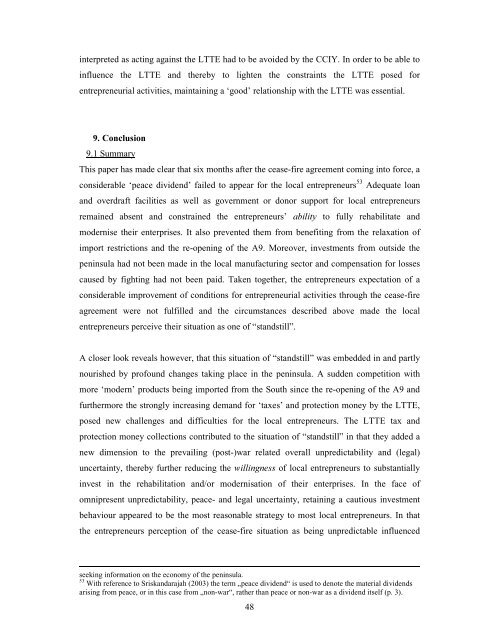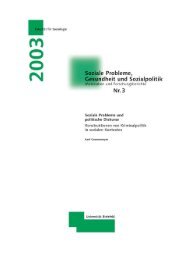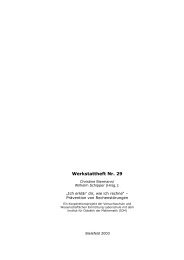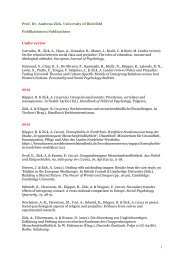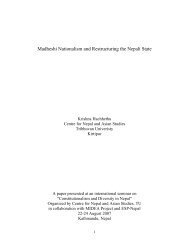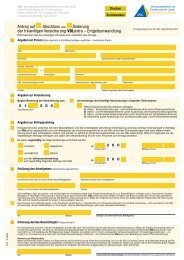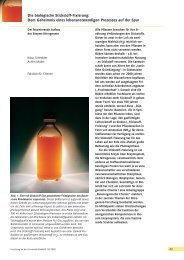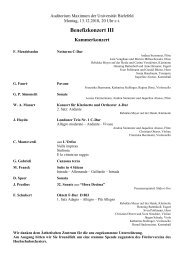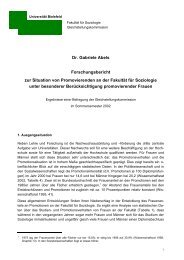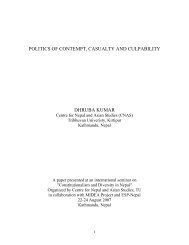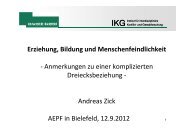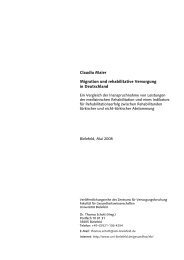Student Research Project Sri Lanka 2002 Supervisors: Prof. Dr ...
Student Research Project Sri Lanka 2002 Supervisors: Prof. Dr ...
Student Research Project Sri Lanka 2002 Supervisors: Prof. Dr ...
You also want an ePaper? Increase the reach of your titles
YUMPU automatically turns print PDFs into web optimized ePapers that Google loves.
interpreted as acting against the LTTE had to be avoided by the CCIY. In order to be able to<br />
influence the LTTE and thereby to lighten the constraints the LTTE posed for<br />
entrepreneurial activities, maintaining a ‘good’ relationship with the LTTE was essential.<br />
&RQFOXVLRQ<br />
9.1 Summary<br />
This paper has made clear that six months after the cease-fire agreement coming into force, a<br />
considerable ‘peace dividend’ failed to appear for the local entrepreneurs 53 Adequate loan<br />
and overdraft facilities as well as government or donor support for local entrepreneurs<br />
remained absent and constrained the entrepreneurs’ DELOLW\ to fully rehabilitate and<br />
modernise their enterprises. It also prevented them from benefiting from the relaxation of<br />
import restrictions and the re-opening of the A9. Moreover, investments from outside the<br />
peninsula had not been made in the local manufacturing sector and compensation for losses<br />
caused by fighting had not been paid. Taken together, the entrepreneurs expectation of a<br />
considerable improvement of conditions for entrepreneurial activities through the cease-fire<br />
agreement were not fulfilled and the circumstances described above made the local<br />
entrepreneurs perceive their situation as one of “standstill”.<br />
A closer look reveals however, that this situation of “standstill” was embedded in and partly<br />
nourished by profound changes taking place in the peninsula. A sudden competition with<br />
more ‘modern’ products being imported from the South since the re-opening of the A9 and<br />
furthermore the strongly increasing demand for ‘taxes’ and protection money by the LTTE,<br />
posed new challenges and difficulties for the local entrepreneurs. The LTTE tax and<br />
protection money collections contributed to the situation of “standstill” in that they added a<br />
new dimension to the prevailing (post-)war related overall unpredictability and (legal)<br />
uncertainty, thereby further reducing the ZLOOLQJQHVV of local entrepreneurs to substantially<br />
invest in the rehabilitation and/or modernisation of their enterprises. In the face of<br />
omnipresent unpredictability, peace- and legal uncertainty, retaining a cautious investment<br />
behaviour appeared to be the most reasonable strategy to most local entrepreneurs. In that<br />
the entrepreneurs perception of the cease-fire situation as being unpredictable influenced<br />
seeking information on the economy of the peninsula.<br />
53 With reference to <strong>Sri</strong>skandarajah (2003) the term „peace dividend“ is used to denote the material dividends<br />
arising from peace, or in this case from „non-war“, rather than peace or non-war as a dividend itself (p. 3).<br />
48


